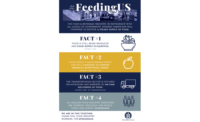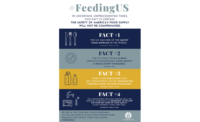The widespread closures of restaurants, hotels, and other foodservice outlets resulting from the coronavirus pandemic have led to a dislocation in food demand. In this note, Rabobank looks at how different sectors are responding to this dislocation and the challenges food processors are facing to convert production from foodservice to retail items, aiming to ensure supply at grocery stores and offset losses from lower foodservice activity.
Shifting demand, shifting supply
Rabobank estimates that every 10 percent drop in out-of-home food spending (e.g. restaurants, cafes, cafeterias, etc.) translates into approximately an additional 3 percent in retail food spending. This estimate seeks to provide food players and grocery stores a sense of the magnitude of the challenge we face in feeding a population that—from one day to the next—was told to stay at home.
This scenario brings to food industry players the challenge of increasing retail supply amid a virus pandemic. The logical first step is to maximize production running rates, but converting foodservice lines and portfolios into retail also becomes a way to access fresh supply and support foodservice providers affected by the abrupt closures.
Unprecedented operational challenges
To a limited extent, foodservice production has already been converted to retail sizes, brands, and specifications. It is a less problematic task for players that supply both segments, although dedicated lines and availability of retail-size packaging and labels may represent a constraint.
However, there are specific challenges to take into account, which vary by sector. In this note, we intend to outline, sector by sector, the actions that are being taken and the challenges players are facing to divert supplies from foodservice to retail channels.
Baked goods
Bakeries have benefited from increased demand for fresh items in the retail segment. Fresh bakery players, who are well-positioned to pivot production to their retail portfolio, are looking to hire over 3,000 employees to start immediately. As baked items have a short shelf life, sales of baking ingredients, such as flour and yeast, have surged significantly (+17 percent and +52 percent, respectively, in the first week of March, according to IRI), indicating home baking could absorb some of the extra demand.
Of the three major packaged-bread manufacturers in the country, only two have exposure to foodservice. Within foodservice bakery, the main clients are quick-service restaurants (QSR), which are expected to be less affected due to their drive-thru structures (takeout), lower average ticket, and client age profile.Pure foodservice players, usually in the frozen bakery segment, will be affected the most. Around 76% of foodservice baked goods consumption is sourced from the frozen segment, a USD 12bn business. In retail, the only possible alternative outlet is grocery stores’ in-store bakeries, but to a much smaller extent since this segment accounts for only USD 5bn in frozen intake, and stockpiling has made visits to grocery stores less frequent.
A tale of two channels
The initial stockpiling stage that led to empty shelves and lines at grocery shops’ doors seems to be behind us. Consumers have adapted to new shopping routines and added stocks to their fridges and pantries. Food companies and retailers have accepted the challenge to keep running and make more food available for consumers during the unfolding crisis. On the production side, there are no signals of a major disruption in the production chain other than isolated cases.
This is an unprecedented and uncertain environment for all. Challenges and opportunies vary by sector, product, and company. In all sectors analyzed above, however, flexibility in production and a diversified client base remain common key assets for companies to navigate through the demand dislocation.
In this environment, players with high exposure to foodservice are the ones to feel more pressure. Exploring supply gaps in the retail channel remains as an opportunity to offset—at least partially—revenue losses from foodservice. However, pressure may still be felt, as some products are mostly consumed outside the home, such as prime meat cuts, seafood, difficult-to-prepare dishes, and frozen baked goods, and don’t translate into retail in a one-to-one conversion. In addition, some players may face limited availability of retail-size packaging, different specifications, and distribution constraints, as well as working capital restrictions during these turbulent times.
Given the dynamism of the current crisis, we will continue to provide updates on the current state of the food supply chain as new data comes out. Looking forward, we will work to forecast key shifts in consumer behavior, potential new or fading trends, and corporate strategy reviews in the pandemic aftermath, also taking into account the likely deterioration of the economic landscape.
Analysis of other industry segments is available on the full Rabobank report, which you can find by clicking here.





